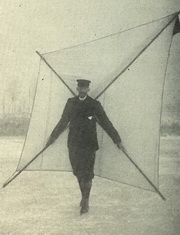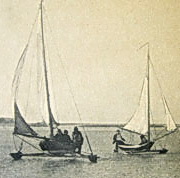
Sailing and surfing are popular summer sports in the
wind dominated Netherlands. And speed skating is the national winter
sport. So, for a Dutchman propelling forward on ice skates by means of a
sail should not be a strange thought. But reality is different. Though
ice sailing with boat like objects is practised in clubs, skate sailing
has seldom been seen.
Until I came across the
jubilee book of
the Stockholm Skate Sailing Club in the spring of
2009 I did not have a clue of it. From the book it
became clear that in Sweden this skating discipline
is more than 100 years young. As it is in North America
I coincidently learned a few weeks later, when I was
approached by Richard Friary, an American skate
sailor and author of a book describing
the sport comprehensively in detail.
I knew about ice sailing but it is quite different from skate
sailing. For ice sailing you need a 'boat with mast
and sails'. The boat must be flat bottomed and
provided with three runner blades, two fixed and one
revolving as to make it suitably for steering. This
way of moving along in the
Netherlands has its roots in the 17th century or
earlier when in winter time both people and goods
were transported over the ice in the frozen canals
by means of sailing sledges.
But skate sailing? I had never heard of it except
that I had got a few pictures from around 1900
showing skaters carrying sails on frozen lakes in
France and Germany, as the one at the top of this
page. It then seems to have been popular by the
upper class in those countries.
Skate sailing has much in common with wind surfing.
But two main differences should be emphasized.
First, the sail is not anchored to something at the bottom.
Second, the skate sailor stands at the other side of
the sail. The skate sailor keeps the sail between
him and the wind; the wind surfer stands between the
wind and the sail. The skate sailor leans against the
wind. He is pushed forward whereas the wind surfer is
drawn.
The skating sail traditionally has the shape
of a large kite. It consists of a light frame of
crossed poles, draped with wind tight textile. The
skater lies the horizontal pole on the windward
shoulder at the cross with the vertical pole. By moving the sail forward or backward and revolving
it more or less the skater can regulate his course
and speed. Through the years experienced skate
sailors have experimented quite a lot with different
shapes and sizes of the sails.
Skate sailors need sharp ice skates as to cope with
the gradient under which they lean against the wind. Also
their ice
skates need a certain tallness in order to keep
standing at little angles. As the size of the sail
that can be carried with also depends on the height of
the shoulder over the ice surface some skate
sailors use stilts as can be seen in the pictures at
the right.
Yet skate surfing is coming up as well. As is the
use of delta wings for sails. They make it possible
to jump as with kite surfing. I found a Swedish film
at YouTube showing spectacular possibilities:
Sources:
Friary, Richard: Skate Sailing, a complete guide;
1996
Richard, Allan e.a.: Stockholms Skridskoseglarklubb
1901-2001
http://home.swipnet.se/ansar

Skate sailing c. 1900

Ice sailing c.1920.

Making fun c. 1930

Skate sailing c. 2000.
It is a bit hard to see,
but the skater is moving in the direction of the observer. The wind blows from the left and the skate sailor leans against sail and wind.

Two Swedish skate sailors with stilted ice skates.

These sailing skates have removable
stilts.
The owner can stand maximum 30 cm above ice. Using other lengths he can
adjust this tallness.
Thus he can use a larger sail with weak winds and a smaller one when it
blows hard.
© 2002-12 The virtual Ice Skates
Museum. All rights reserved.
home |
sitemap |
copyright |
contact